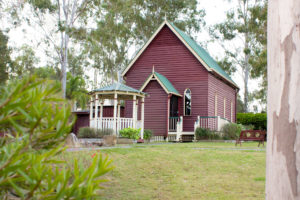In the days of the large grazing leases, this are was known as Gimboomba. It was taken up by Thomas Dowse in 1845 until 1848 when it was transferred to Sydney publican Robert Rowlands. In 1851 it was taken up by Andrew Inglis Henderson and operated as a sheep run and later cattle grazing.
The first hotel established there by Alex and Agnes Jennings in 1880 was known as the Norfolk Hotel. Steven Tudman took over this hotel in 1882 when the Jennings moved to the Waterford Arms Hotel. In May Henry Markwell applied for a licence for a hotel in Jimboomba, and was building a new house for the purpose. In June 1885, Samuel Manning took over Tudman’s hotel and renamed it the Traveller’s Rest. Markwell withdrew his application at that time. Manning maintained the licence in 1886. He moved to the Railway Hotel in 1888. Presumably all this hurried activity in Jimboomba was due to the pegging out of the railway survey, which had reached the fledgling town by March.
In 1885 the Beaudesert Railway was being pegged out and the siting of the line through Jimboomba ensured the prosperity of the locality for many years to come. The Jimboomba Station became a place for timber getters to load timber and a sawmill had already been established near the station by C Smales in 1883.
In May 1890 the Jimboomba provisional school was established in a hall owned by the Presbyterian Church. Patrick Culligan from North Maclean was the first teacher. Local Alex Harrison was appointed teacher in 1892. A new school building was constructed in 1900. Another school was established in Western Jimboomba in 1899 in the Jimboomba Timber Reserve. It was known as Martindale and was relocated to Cedar Grove in 1923. The original site was in the vicinity of Gittins Road, to the south of the Flagstone Estate.
Following the demise of the Waterford Bridge in the flood of 1947, Jimboomba residents feared that their many requests for a high bridge would again be held back while Waterford was prioritised. Eventually in mid 1948 their efforts were rewarded with the announcement of a new bridge 13 feet (almost 4 metres) higher than the previous one.
The area continued to grow slowly. A community hall was built in December 1953.
The first significant shopping centre was built in 1984.
Hills International College commenced construction in 1991 on the former property of Andrew Inglis Henderson.
Flagstone Community College opened in 2002 as did Emmaus College.
Dorrington House (pictured below) was donated to Jimboomba Rotary by Alan Dorrington.
It was originally located on Queen Street, Jimboomba and was moved to it’s current location on Johanna Street, Jimboomba. Dorrington House was one of the original homesteads in the region. It was officially opened in it’s current location by 2006-2007 Club President Mal Strachan & Rotary International District 9640 District Governor Douglas Geekie on December 9, 2006.
The Little Brown Church (also pictured below) was originally the Old Jimboomba Church and was an interdenominational venue for services from circa 1909 until 1967, when it was acquired by the Uniting Church who used it until 1988. It was donated to Jimboomba Rotary by Uniting Church to save it from demolition, when it was moved in 1999. It was originally located on Mary Street, Jimboomba and was moved to it’s current location on Johanna Street, Jimboomba
